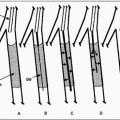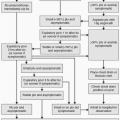Preprocedure Preparation
1. History and physical exam should be performed, with a focus on the vascular system. The operator should perform the peripheral vascular exam and document locations and quality of pulses in the bilateral extremities.
2. Pertinent noninvasive imaging (pulse volume recording [
PVR], multilevel segmental lower extremity brachial indices, computed tomographic angiography [
CTA], or magnetic resonance angiography [
MRA]) should be reviewed or obtained if necessary.
3. Preprocedure laboratory evaluations should include platelet count, creatinine/glomerular filtration rate (
GFR), and coagulation profile.
4. Baseline ankle-brachial index (
ABI) should be obtained prior to procedure.
5. Evaluation of acetylsalicylic acid (
ASA) status for conscious sedation should be performed.
6. Patients should halt oral intake as per institutional protocol.
7. Morning insulin dose should be reduced to half for patients for whom food is withheld.
8. If a contrast allergy exists—steroid pretreatment should be given (see
Chapter 64).
9. For non-dialysis-dependent renal insufficiency, hydration with 0.9% saline at 1 mg/kg/h for 24 hours beginning at 2 to 12 hours prior to the procedure is recommended for patients without congestive heart failure. Although not routinely used in our practice, sodium bicarbonate and
N-acetylcysteine may be helpful, but the data are equivocal (
1). See
Chapter 65.
10. Patients are started on dual antiplatelet therapy 1 week prior to intervention with 325 mg of aspirin and 75 mg of clopidogrel daily. Otherwise, 325 mg of aspirin and 300 mg of clopidogrel (loading dose) are administered prior to the procedure. Individual patient response to clopidogrel is not routinely evaluated.
11. Urinary bladder catheter is usually placed prior to the procedure.
12. Sterile preparation, including surgical clipping, of both inguinal regions and/or arm is performed.
13. Procedures are performed under conscious sedation with incremental intravenous aliquots of midazolam and fentanyl with hemodynamic and respiratory monitoring.
14. Prophylactic antibiotics are not routinely administered for aortoiliac interventions performed under sterile conditions, even for those with cardiac valve prostheses, or mitral valve prolapse or other valvulopathy.







